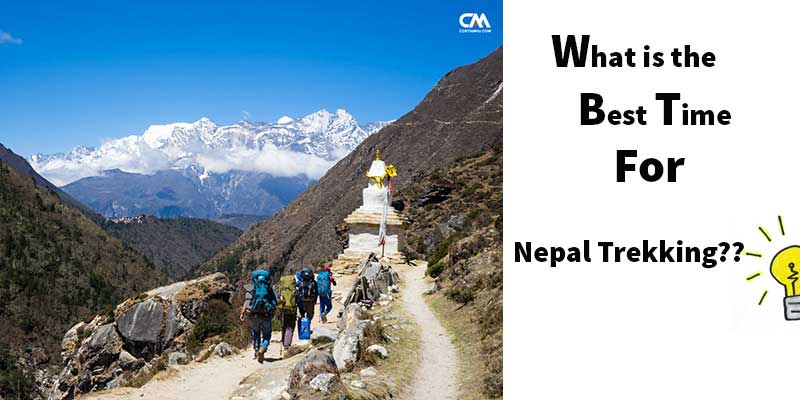Best Time for Nepal Trekking

- 12-Sep-2016
- 0
It’s not about having time. It’s about making time.
A land of geographic icons, historic adventurers, and monumental landscapes, Nepal sits in the shadow of Everest but shines with myriad treasures. Nepal is amazingly rich and varied in its biodiversity due to the attitudinal variances, which makes Nepal a country of lush moist forest and sparse alpine desert to luxurious grasslands.
National parks hiding rare wildlife, vibrant cities filled with art and culture and simple villages preserving an ancient way of life make Nepal a constant source of inspiration for curious globetrotters in search of enlightening experiences. Nepal's climate is primarily temperate, with some tropical and alpine regions. From June until August the monsoon hits, making it too wet and humid for trekking. The post-monsoon period from September to November is a rice-harvesting season and is characterized by lush vegetation, clean air, and excellent mountain views. Days are warm and sunny, although nights become increasingly cool. This is the start of the trekking season, which runs until May. Winter (December to February) is dry and clear with temperatures dropping below freezing at high altitudes, although in Kathmandu, it can still sometimes reach a pleasant 25 C. Spring (March to May) is warmer and is a particularly beautiful time to visit as the rhododendrons and the orchids are in flower.
Autumn:
Considered the best trekking season in Nepal, it’s hard to fault the clear skies, moderate days, and fantastic trekking conditions that autumn brings. After the monsoon the dust and pollution are cleared from the atmosphere, making way for crystal clear views and with it, stunning panoramas of the Himalayan mountain ranges.
Depending on the intensity of the monsoon, the best time to trek generally starts around mid-September. Once the weather has settled, most days feature clear blue skies and a bright sun that lasts throughout the day, unlike in spring, when cloud builds up in the afternoon. Towards December the evenings begin to cool off quite quickly, especially at higher altitudes, making warm trekking gear and sleeping bag a must.
Spring:
Considered one of the best seasons to trek and climb in the Himalaya, spring brings not only with it the sun and warmer temperatures, but fields of blossoming wild flora such as the famous giant rhododendrons, giving the landscape a radiant and vibrant texture.
If you’re after warm temperatures, blossoming flora, and temperate days, spring is the ideal season to trek in Nepal. Early spring tends to be a bit chilly, with mild temperatures in the low elevation regions (800-2000m), making trekking in regions such as lower Annapurna very pleasant. As winter fades away and spring pushes in, temperatures in regions with elevations over 4000m have moderate temperatures, making way for sunny, clear, and warm trekking conditions.
Summer:
Summer typically brings the monsoon rains from late May to mid-September in Nepal, so trekking during this time is not typically recommended in Nepal. With the monsoon comes high temperatures, considerable rain, and uncomfortable conditions. Mountainous regions are usually enveloped in clouds, and the lower routes are generally muddy with large numbers of leaches.
However, this doesn’t mean that you can’t experience the glory of the Himalayas from June to August! This is THE time to trek in the Indian Himalaya and Ladakh is incredible this time of year. Protected from the monsoon and high on the Tibetan plateau, Ladakh enjoys a largely dry climate throughout the summer months, with clear skies, uninterrupted views, and stunning scenery.
| Doable during monsoon with expected monsoon troubles | Highly Recommended to do in Monsoon |
| Everest Base Camp Trek
Jiri to Everest Base Camp Trek Everest Gokyo Lakes and Gokyo Ri Trek Shivapuri-Dhulihel-Panauti Trek Dhulikhel-Namobuddha-Balthali Village Trek Sundarijal-Nagarkot-Changunarayan Trek
|
Upper Mustang Trek |
Winter:
For most people it is too cold to trek to high altitude regions in winter in Nepal; daytime temperatures can range between 9-12ºC, and evenings can drop to sub-zero temperatures. If the cold doesn’t bother you, it is a great time to trek to the more popular places such as the Everest region, because there are far fewer people around compared to October and November, as well as the lower to mid-altitude trails, where the temperature remains fairly pleasant. Our Christmas and New Years' treks in Nepal are always very popular for just this reason.
Mornings can start foggy, but afternoons are usually clear with the occasional snow in the mountains. With this in mind, high passes such as Thorong La (5416m) in the Annapurna region, and the Kongma La (5545m), Cho La (5335m), and Renjo La (5420m) in the Everest region are usually closed from late November to March.
Nepal has become a Mecca for trekking lovers who want to explore the Himalayas. But due to the varied weather patterns and seasonal changes, the trekking gets harder and tougher, that’s why you should plan a trek by deciding the perfect month that matches your ideal type of weather condition. Autumn is the most preferable season to trek in Nepal but at the end of the day, it’s up to you to decide when to come here for trekking so it can be any season you want as trekking is done all year round in Nepal. So choose your favorite time of the year and come visit Nepal.
| Excellent to trek in winter | Doable with good preparation for cold conditions |
| Everest View Trek
Shivapuri-Dhulihel-Panauti Trek Dhulikhel-Namobuddha-Balthali Village Trek Sundarijal-Nagarkot-Changunarayan Trek
|
Everest Base Camp Trek
Jiri to Everest Base Camp Trek |




